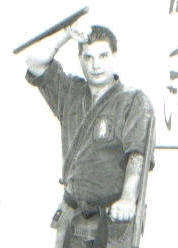
MARTIALFORCE.COM
PRESENTS
AN INTERVIEW WITH
Steve Malanoski,Hanshi

By Shihan William Rivera
Martialforce.com
Shu Ha RI
The term Shu Ha Ri is an idea or concept that is often associated in the martial arts with the development of a student and with the preservation and progression of a style. Considered stages in the development of a martial artist, the three terms can be translated as follows:
Shu – The knowledge given to you (Tradition)
Ha – The development, hone or sharpening of the knowledge (Understanding)
Ri – The break or departure from the knowledge (Enhancement)
Shu Ha Ri follows you within every level of your martial arts training. From beginner to black belt, to instructor, to master, and beyond. Though traditional and fundamental, and for reasons we can discuss in a future article, its concepts are not often presented nor mentioned along with instruction.
With this said, we are fortunate that many of our great instructors and masters embellish the essence of Shu Ha Ri. The common denominator central to attainment of their goals was learning early on that training is always ongoing. Just as important, that students need to be aware of possessing the ”right stuff”, the untapped potential of special qualities which lies within each of us.
Hello and welcome to Martialforce.com. My name is William Rivera a Yudansha and student of Eddie Morales Shihan.
One afternoon, while at the home of my co-editor for Martialforce.com her precocious twelve year old daughter bombarded me with a slew of questions about the martial arts: ”How does someone become a master?”
“How do you create a style?”
“If I started as a little kid when would I get my black belt?”
Just as I began to answer her questions, she interrupted with two more (I said she was precocious).
“Do you know a martial artist who began his training as a little boy?”
“Can you tell me his story?”
Now, it was not the questions themselves that struck me, rather, her inquisitive nature to want to learn more, and a request for an example. With that in mind, I decided to write an article and interview a martial artist whose journey did begin as a child and continues to the present.
“This is about the Martial Arts and the story just happens to be on Steven Malanoski.”
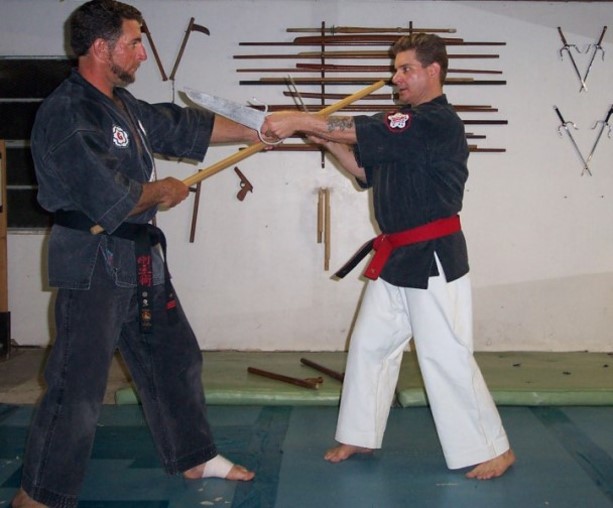
I approached Steven Malanoski Hanshi with the idea of writing an article describing his life in the martial arts. I asked for a map of his journey from beginning to present. As a tour guide, he would lead me through the many paths he has taken, over numerous discussions spanning several months.
As anyone who has known Steven for many years, or met him for five minutes can attest, he is extremely direct, candid and painfully honest (it is certainly reflected in our interview). He is a gentleman of humble beginnings who became a giant among the best the martial arts has ever produced.
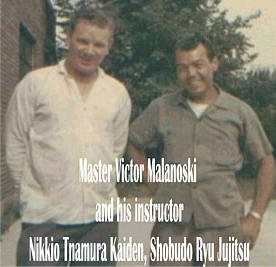
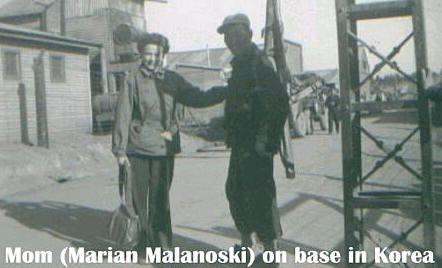
Steven Malanoski was born July 26, 1960, son to Marian and Victor. Interesting enough, his parents were not your typical suburban types. They were vaudevillian players who traveled around the world and performed in variety shows like Ed Sullivan’s and Abbott and Costello’s. Victor Malanoski served as a Marine during the Korean War. Stationed in Hokkaido, Japan where his unit was deployed from he studied various martial arts. During this time he would attain his black belt equivalent in Shobudo Ryu Ju Jitsu the art, he would devote his life to.
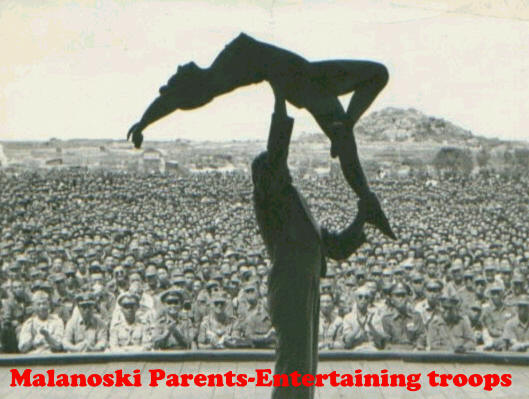
After his tour, Victor and his wife joined the USO. Using their vaudeville skills along with an act that included hand balancing, music and adagio (in ballet or dancing a slow and flowing movement) they traveled to the orient. This allowed Victor Malanoski to further train his martial arts, specifically in the style he would become a master in Shobudo Ryu Ju Jitsu.
Steven Malanoski grew up on the Lower East Side of Manhattan, in New York City. Steven was highly inquisitive and active as a child. To this day he still remembers and thanks his mother for the following words: “Victor, if you are going out, you better take Steven with you!”
Those words began his Shu Ha Ri, his journey into the world of the Martial Arts. Steven’s father was Master Victor Malanoski, (whose instructor was Nikkio Tnamura Kaiden, Shobudo Ryu Ju Jitsu), and he brought Steven everywhere he went. Young Steven was introduced to the martial arts long before he set foot into a dojo to begin his training. Whenever his father visited dojo, or practiced with various martial artists, along came Steven in tow.
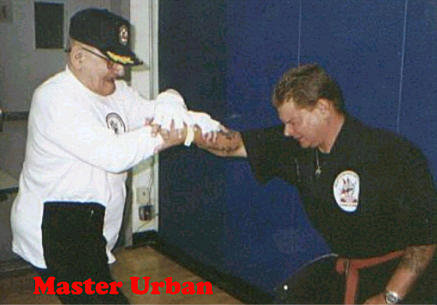
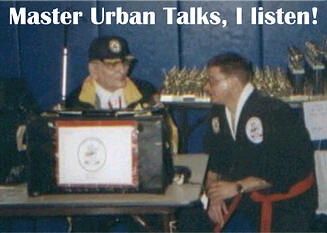
My opening question to you is, why have you allowed us to learn about your life, to open yourself and share your story with us, (you obviously have a story worth telling)?
“If indeed my experiences can be considered a story, perhaps it can be helpful to students. You came to me; it is not an ego thing. I am just answering your questions. The martial arts have brought me down many long and difficult paths, but they have been rich in rewards along the way. Yes, I have been honored. I trained with great instructors and developed valuable lifelong relationships with fellow martial artist, too many to tell.
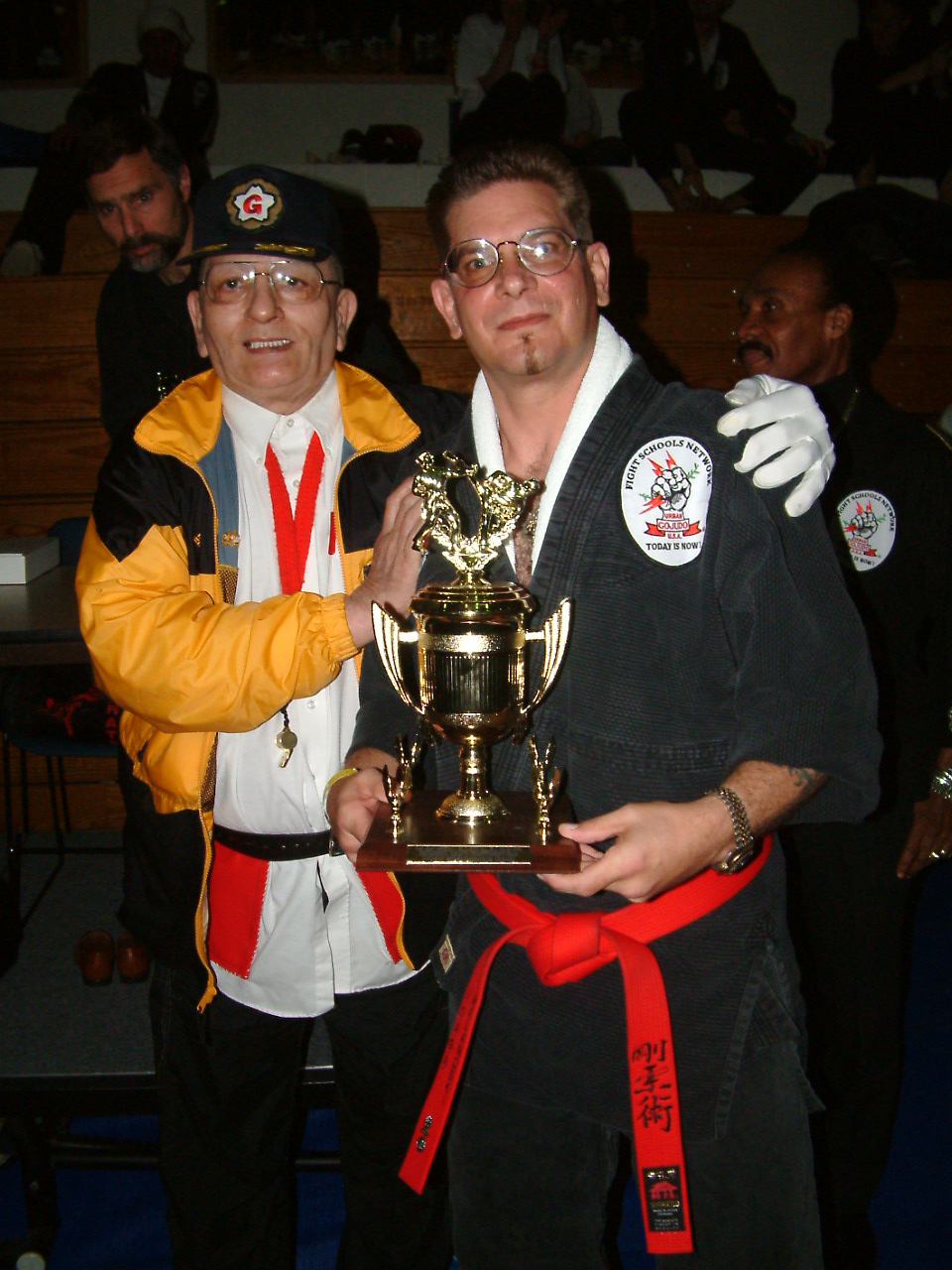

The important point is this: You have heard the expression, sometimes it’s not the destination but the ride that counts? That is what I want students to get. Yes, Shu Ha Ri, is at the heart of your training. The journey taken is always continuous and follows different paths along the way. This is what your martial art should be. It is very important.”
When did you start training in the martial arts?
“I began my training at the age of 5 in the style of Shobudo Ryu Ju Jitsu. My instructor was my father Victor Malanoski (now deceased). My training in Karate began at age 8 with instructor, Maestro Peter Urban the Grand Patriarch of All-American Goju Systems. He continues to be my instructor, and my mentor till today.”
Your father did not let you formally start training until you were five; did Master Victor Malanoski feel that before that you were too young?
“My father believed that you should be able to maintain yourself and interact in an official setting before you could practice the martial arts. The art he learned and taught was Shobudo- Ryu Ju Jitsu with the intention of training for a life and death confrontation. It was not considered, as some would say, user friendly. The training was harsh and strict.”
Taking you back to those first classes in Shobudo-Ryu and USA Goju, can you, give us some insight?
“Though there were some similarities in training, the methodology used at each dojo was quite different. My early recollections of attending training with my father were quite vivid. I believe the best way to describe his style of training was one of spellbinding effect, but underlining it was intimidation. During instruction, his students would listen intently to his every word, his every phrase, and every detail. The driving force was fear, fear to fail. Any mistake was totally unacceptable. There was only one way, to do a form, no deviation, no interpretation was ever allowed. My father spoke, we listened, you did it, and that was it.”
When I began instruction at Maestro Urban’s dojo (at eight years old), I felt intimidated, as if I was a lost rabbit in a large forest. There I was, surrounded by students all much older than I. All of them knew what they were doing, and were working amongst themselves or independently. Suddenly, a loud bell would ring, next thing you heard was the voice of Master Urban “Now here this, Now here this, Prepare for training”. Everyone would quickly position themselves accordingly on the floor by rank and snap to attention.
Maestro Urban was certainly militaristic and regimented in his style of training. The difference was that he injected into his students, a sense of belonging to something very special, USA Goju. He was certainly “colorful” in his ways, with boundless energy and spirit. Above all, he is an intellectual.”
At the age of 12, Malanoski Hanshi was granted his Shodan-Ho (junior black belt) and his Oku-Iri (entering level) ranking in USA Goju and Shobudo Ryu in Ju Jitsu. (NOTE: Shobudo Ryu Ju Jitsu as taught by Master Victor Malanoski used the Ko Ryu method of ranking known as the Menkyo ranking system.)
Both his father, Master Victor Malanoski, and Maestro Peter Urban did not believe in awarding a black belt to a student before the age of eighteen.
Did martial arts training come easy, were you a natural?
“Nothing came natural to me. My dexterity was not awe-inspiring. It took me years before I could kick above my belly. The saying, “If I can do this, anybody can” certainly applies to me. What did help me, were my inquisitiveness, dedication and perseverance. Nothing that is exceptional or measured in aptitude or strength. Instead they are traits that everyone has, they just need to be realized and used.”
What inspired you during your beginning years?
“Looking back, I would obviously have to say, it began with my parents. My father grew up during The Depression, which was a very difficult time. Their outlook on life was to always keep a positive frame of mind.
In the dojo, Wow! My sempai were a “Who’s Who List” of some of the greatest martial artists. To name a few: Leon Wallace, Al Gotay, Riley Hawkins, Louis Delgado, and Kow Loon (Kayo) Ong (who is still my sempai to this day and who I go to when I have questions about the Ko Ryu). Some were very competitive, others were harsh, but like family, they took pride in helping me learn and kept pushing me forward.
I remember watching Master Ron Van Clief in tournament, fighting and performing kata. The way he moved, his flow and power mowed down everyone in kumite and took grandchampion in kata. The way he and his students looked during demonstrations inspired me.
Today, in basketball kids say, “I want to be like Mike.” Well in the martial arts, for me, I said, “I want to be like Ron!”
However, I want a little more. During these years how was your training, what helped you become a black belt?
“William let me make it short and sweet. The training was long and repetitive. I performed kata until it was coming out of my ears. I punched, kicked, and fell until it became second nature to breathing. I will say this now and I will probably say it at other point during this interview. What was stressed by Maestro Urban and was drilled into every one was that practice does not make perfect, perfect practice makes perfect. This was important whether you performed ten repetitions or one hundred (it always seemed like thousands).”
Then, I still want more. What made you go back, after you got hurt one hundred times?
“Get off my back (he laughs)! I see what you’re trying to do William. How do you inspire those who are thinking of quitting at this point? Well, the martial arts are not an easy road. For me, looking back, it is important to have an instructor who inspires and commands. It is also important to have dojo brothers, (Sempai-senior, Kohai-junior) who inspire you with that (and you will hear me say this again) never say die attitude. That’s what I had in Maestro Peter Urban and in the dojo.”
Because of space (I only have so many pages I can write), I had to omit many of the names of artists Steven mentioned who were just as inspirational. These included people from USA Goju as while as from other styles. To add a few more: Ron Jeter The Master Breaker, Cecilio Ortiz, Wilfredo Roldan, Rex Lee, Ernest Hyman (nunchaku instructor) got the point? My apologies.
At the age of 18, he was tested and granted his Sandan by Maestro Urban and his Moku-Roku (Catalogue), by his father Master Victor Malanoski.
Before entering the US Marine Corps in 1979, Steven Malanoski was awarded his fourth Dan by Master Urban. His service in the Marines as a (Force) Recon Marine (Parafrog). Detached to the second force “Reconnaissance Company” he was later sent to Okinawa with the 3rd Recon Battalion among other units. (Malanoski requested and was granted three tours of duty to Okinawa). His 4 years as a marine included TAD (temporary assigned duty) in Nicaragua, and El Salvador. While on TAD he was able to meet and workout in the dojo of some of the legendary masters of the martial arts including Gogen Yamaguchi and Mas Oyama.
Did your training in the martial arts prepare you for the training you encountered in the Marines?
“Of course! Basic training was tough. The physical training I received in the arts from my father and Master Urban, including that never say die attitude engrained in me, was a plus throughout my tour of service.”
How did the Marine Corps affect your martial arts training?
“My career and tour of duty with the Marine Corps, provided me the opportunity to travel throughout the Orient. This was a lifetime opportunity to meet some of Karate’s renowned masters, visit and workout in their dojo. In 1980 at the Goju College, I performed sanchin, tensho, and did one step sparring with various black belts as Master Gogen Yamaguchi watched on. I trained in Master Oyama’s dojo while he presided over the classes. I was thrilled to have had the opportunity to workout under the same instructors as Maestro Urban.”
Did your training in the United States prepare you for the training you encountered? Was it up to standards? (He laughs) “I want you to start with your very first encounter upon arriving in Okinawa”.
“Upon my arrival I asked and was taken to the nearest dojo. As I entered, I remember smiling and thinking to myself, I can not wait to get on the floor. You know what? Good, hard training is always respected in the martial arts no matter where you are. With strong kihon (basics) and a fighting spirit, you should be able to enter any dojo and fight with any artist without ever worrying about how you look.
It was the realistic way my father taught me and the principle Maestro Urban always stressed, “Practice does not make perfect, perfect practice makes perfect". That my friend prepared me! Wherever I was assigned overseas, I was afforded the opportunity to train and spar in various dojo of different styles. I did so without ever feeling that my art or performance was substandard.
What I received in return was the respect of others for my strong desire to learn and a never say die attitude.”
Steven Malanoski’s tour of duty with the Marines was from 1979 until 1982, four years. A Force Reconnaissance Ranger, he was also a hand to hand combat instructor. He visited many dojo and practiced with many artists. He competed throughout the Orient including the Naha tournament in 1980 and 1981. While in Korea he received his black belt (dun) in Tae Kwon Do, received Dan rank in Kobudo, as well as training in the style of Naha-Te under the great Arakaki. After his tour ended, he returned back to the United States, and one year later received his fifth Dan from Master Peter Urban and his Menkyo certificate. (Full teacher’s license) in Shobudo Ryu Ju Jitsu from Master Victor Malanoski.
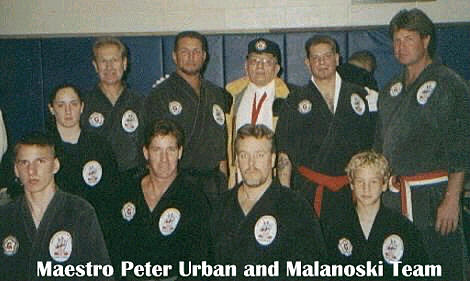
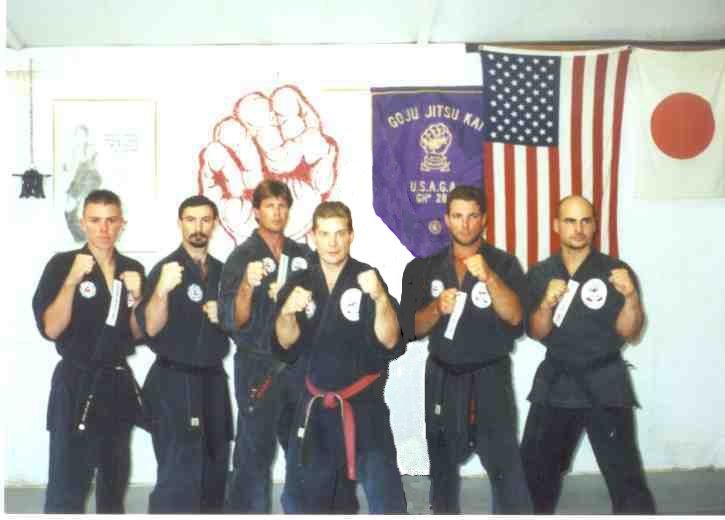
The current active black belt squad under the
personal tutelage of Master Malanoski:
L to R, Robert Updike (Shodan), Frank Scimeca (Nidan), Sensei Calvin Chase (Yodan),
Keith Lengyel (Shodan), Dalton Santiago (Shodan), and
Foreground, Hanshi Malanoski, 9°
“I was a student of great masters. I am just a compass.” Malanoski
My editor is telling me to leave the book for another day, this is an article, remember? With that in mind, before moving on to the final questions, allow me to give you a condensed version of Malanoski Hanshi journey from 1983 until the present.
Without question, his instructor continues to be Maestro Peter Urban who awarded Steven his ninth Dan in 2003. The renowned Master Rex Lee awarded him his sixth Dan in Ju Jitsu. He also attained Dan rank in Judo and Omori Ryu Iaido his teacher was Joe Bass (Jo Hanokami).
Steven has traveled throughout the world and demonstrated his martial arts. He introduced USA Goju to the former Soviet Union in 1996 by giving a demonstration to audiences in the Ukraine. Thousands saw his introduction of the Urban Kata Kururunfa in Alexandria, Ukraine.
In 1996 he was inducted into the World Martial Arts Congress Hall of Fame (there is more that I can list, information from him and what I have researched. Sad to say my editor is threatening me!)
Instead of having my laptop taken away, the history of Shobudo Ryu Ju Jitsu, his practice of Naha-Te, and other aspects including the Great Maestro Peter Urban, will be in discussed in a future article. So to the questions:
It has been said that USA Goju lacks the totality of other systems that fighting is stressed over all.
“Who said that, give me names (he laughs)! That misconception is due to the success of the USA Goju fighters in tournament competition since the inception of the style. What has to be understood is that fighting demonstrations or competition was used to popularize the martial arts throughout the world. This was used by the Goju-kai in its spread of their style as well as the Shotokan style in its propagation.
Was Bunkai part of your USA Goju training?
“Of course it was, and since you are always asking for more, here it is. From day one, the fundamental principles that make up USA Goju were stressed. The classes consisted of a warm-up, kihon, kata and kumite plus! I practiced the kata day in and day out. The kihons were made to become second nature and sparring was done from the very first day I entered the dojo. Bunkai to every kata was taught with the only limits being those you imposed on yourself. Master Urban stressed the use of your brain not just your body.”
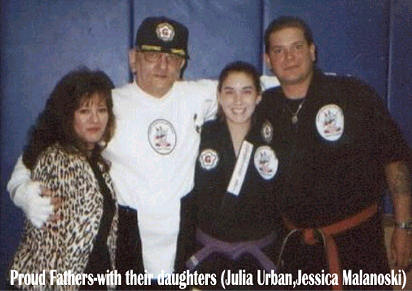
“The situation dictates the rule, everyone is different”. Malanoski